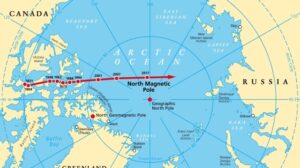Scientists have been surprised to find activity in the Arctic, with the magnetic north pole heading towards Russia in a way that has never been seen before.
As Newsweek magazine reports, the magnetic north pole is the point to which all magnetic compass needles point, and its position changes due to changes in the Earth’s magnetic fields.
At this point it should be clarified that the magnetic north pole is not the same as the geographic north pole, which remains fixed at the intersection of all of the Earth’s Mesembrines.
Referring to the geological phenomenon, Professor William Brown, a modeler of the global geomagnetic field at the British Geological Survey (BGS), speaks to the UK’s Independent newspaper, saying the following: “It’s a big, chaotic ball of molten iron causing turbulence and moving around the centre of the Earth. While we can watch and see how it varies, it’s quite difficult to predict exactly how it will change.”
The “journey” to Siberia
The magnetic pole has been moving along the northern coast of Canada for centuries. In the 1990s, however, it drifted into the Arctic Ocean and has since begun accelerating toward Siberia.
From 1600 to 1990, it is estimated that the magnetic north pole moved by about 10-15 km per year. In the early 2000s, the speed of its movement increased to about 55 kilometers per year, according to Professor Brown.
In the past five years, the magnetic north pole has slowed down considerably, with its motion reaching about 25 kilometers per year, according to the Israeli newspaper Jerusalem Post.
The data comes from the World Magnetic Model (WMM), which has been established by the British Geological Survey (BGS) in collaboration with the US National Oceanic and Atmospheric Administration (NOAA). The model predicts the pole’s position at any given time and its latest update is expected to be released in December.
“The Global Magnetic Model is embedded in almost every piece of technology, from smartphones to cars to military aircraft,” Professor Brown said.
The movement of the pole is caused by unpredictable fluctuations in the turbulence of the molten iron that makes up most of the Earth’s outer core. The liquid metal moves due to heat escaping from the planet’s core, creating the Earth’s magnetic field.
The field and the position of the magnetic pole are affected by the fluctuations in the swirling motion of this molten iron, which is about 3,200 kilometers (3,200 miles) below the Earth’s surface.
Note that predicting the exact movements of the magnetic pole is impossible, but the British Geological Survey (BGS) uses a network of ground stations and satellites to map the Earth’s magnetic field in different parts of the world.
Ask me anything
Explore related questions





